SpringMVC 源码解析
2019-08-26 06:22:30来源:博客园 阅读 ()

SpringMVC 源码解析
前言
? ? ? ? 年初面试时接触到一道面试题,在聊到SpringMVC时提到了SpringMVC的开发者为何要设计父子容器呢,又或者说是父子容器的设计有什么更实际的作用呢?
? ? ? ? ?首先要理解对于一个web应用,当其部署在web容器上时,容器会为其提供一个全局上下文环境ServletContext,这个上下文环境将为后续的Spring提供宿主环境。
SpringMVC工作流程
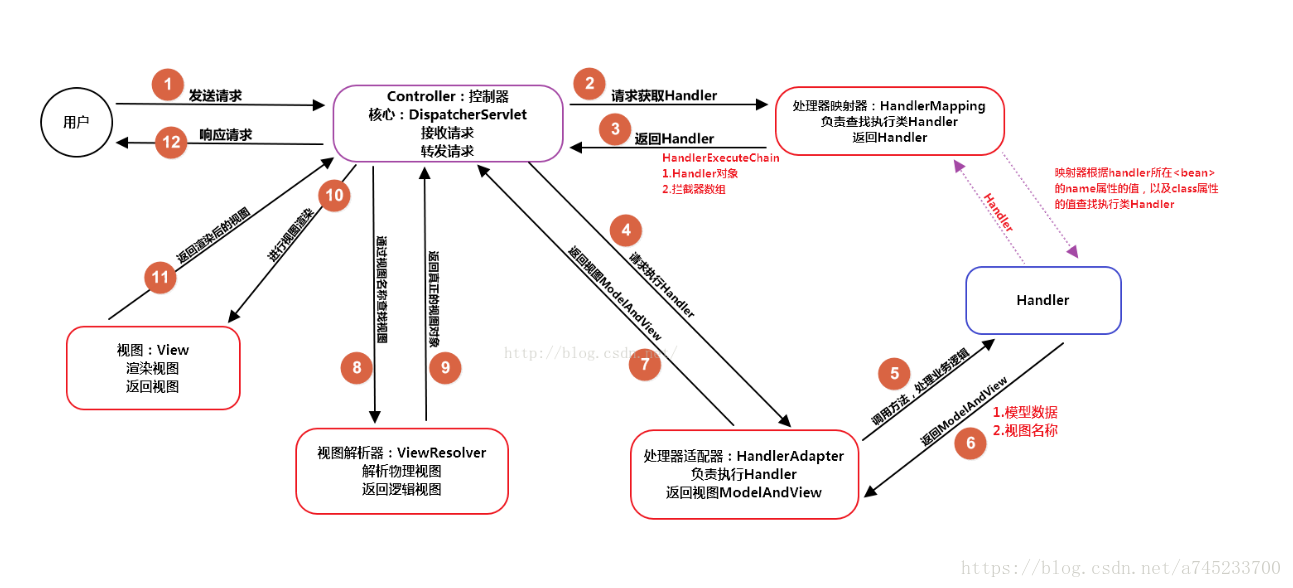
DispatcherServlet上下文继承关系
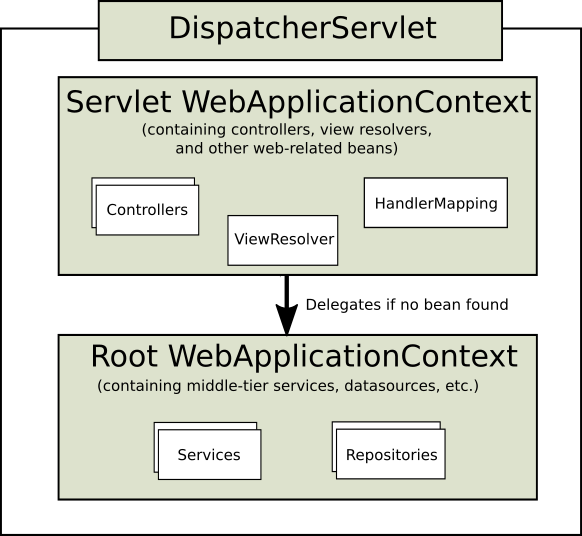
SpringMVC设计的父子容器
父子容器配置文件
--在web.xml中配置,两个重要的xml:applicationContext.xml和SpringMVC-conf.xml
<context-param>
<param-name>contextConfigLocation</param-name>
<param-value>classpath*:applictionContext.xml</param-value>
</context-param>
<listener>
<listener-class>org.springframework.web.context.ContextLoaderListener</listener-class>
</listener>
<servlet>
<servlet-name>dispatcher-servlet</servlet-name>
<servlet-class>org.springframework.web.servlet.DispatcherServlet</servlet-class>
<init-param>
<param-name>contextConfigLocation</param-name>
<param-value>classpath*:springMVC-conf.xml</param-value>
</init-param>
</servlet>
<servlet-mapping>
<servlet-name>dispatcher-servlet</servlet-name>
<url-pattern>/*</url-pattern>
</servlet-mapping>父子容器的设计目的
? ? ?根据SpringMVC的官方解释,父(根)容器主要包括一些基础脚手架的bean,比如Pool、DataSource、Dao、Service。目的是在不同的Servlet实例之间共享。这些不同的bean可以在子容器中重写。
? ? ?而子容器主要包括一些Controller、View等一些web相关的bean。?
DispatcherServlet源码分析
? ? ?既然SpringMVC中同时包含Spring容器和SpringMVC容器,那么这两个容器都是在什么时候初始化呢?
根容器初始化
? ? ? 首先,根容器是通过ServletContext监听器进行创建,默认的监听器为ContextLoaderListener,当web应用启动时,会调用监听器的contextInitialized方法。
? ? ? 那么根容器的初始化就从ContextLoaderListener类说起吧,,Spring官方对该类的描述是启动监听器去启动和关闭Spring的root WebApplicationContext(翻译的实在有点蹩脚)。
? ? ?
public class ContextLoaderListener extends ContextLoader implements ServletContextListener {
public ContextLoaderListener() {
}
public ContextLoaderListener(WebApplicationContext context) {
super(context);
}
//===初始化root WebApplicationContext===
@Override
public void contextInitialized(ServletContextEvent event) {
initWebApplicationContext(event.getServletContext());
}
@Override
public void contextDestroyed(ServletContextEvent event) {
closeWebApplicationContext(event.getServletContext());
ContextCleanupListener.cleanupAttributes(event.getServletContext());
}
}? ?
//ContextLoader.java
public WebApplicationContext initWebApplicationContext(ServletContext servletContext) {
//初始化Spring容器时如果发现servlet 容器中已存在根Spring容根器则抛出异常,证明rootWebApplicationContext只能有一个。
if (servletContext.getAttribute(WebApplicationContext.ROOT_WEB_APPLICATION_CONTEXT_ATTRIBUTE) != null) {
throw new IllegalStateException(
"Cannot initialize context because there is already a root application context present - " +
"check whether you have multiple ContextLoader* definitions in your web.xml!");
}
try {
//创建webApplicationContext实例
if (this.context == null) {
this.context = createWebApplicationContext(servletContext);
}
if (this.context instanceof ConfigurableWebApplicationContext) {
ConfigurableWebApplicationContext cwac = (ConfigurableWebApplicationContext) this.context;
if (!cwac.isActive()) {
if (cwac.getParent() == null) {
ApplicationContext parent = loadParentContext(servletContext);
cwac.setParent(parent);
}
//配置WebApplicationContext
configureAndRefreshWebApplicationContext(cwac, servletContext);
}
}
/**
把生成的webApplicationContext设置成root WebApplicationContext。保存在ServletContext上下文中。
下一步初始化MVC ApplicationContext时需要从ServletContext取出根上下文作为其父上下文。
**/
servletContext.setAttribute(WebApplicationContext.ROOT_WEB_APPLICATION_CONTEXT_ATTRIBUTE, this.context);
ClassLoader ccl = Thread.currentThread().getContextClassLoader();
if (ccl == ContextLoader.class.getClassLoader()) {
currentContext = this.context;
}
else if (ccl != null) {
currentContextPerThread.put(ccl, this.context);
}
return this.context;
}
catch (RuntimeException | Error ex) {
servletContext.setAttribute(WebApplicationContext.ROOT_WEB_APPLICATION_CONTEXT_ATTRIBUTE, ex);
throw ex;
}
}? ? ? 以上代码主要完成两个功能:创建实例WebApplicationContext实例、把所创建的WebApplicationContext设置为根上下文,也就是设置成为ROOT_WEB_APPLICATION_CONTEXT_ATTRIBUTE的值。
MVC容器初始化?
? ? ? 大家知道Servlet生命周期都是从init方法开始,desctory方法结束,由jvm负责垃圾回收。而DispatcherServlet也是一个普通的Servlet,先看一下DispatcherServlet的继承关系图,对整个继承关系有个了解。
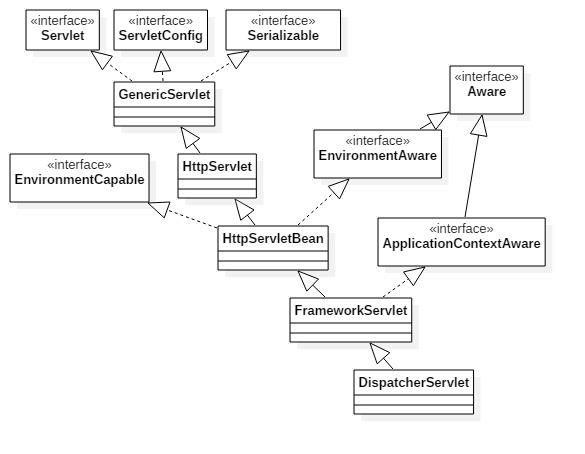
? ?既然说起Servlet,那就从Servlet的初始化(init)方法入手
//HttpServletBean.java
@Override
public final void init() throws ServletException {
PropertyValues pvs = new ServletConfigPropertyValues(getServletConfig(), this.requiredProperties);
if (!pvs.isEmpty()) {
try {
BeanWrapper bw = PropertyAccessorFactory.forBeanPropertyAccess(this);
ResourceLoader resourceLoader = new ServletContextResourceLoader(getServletContext());
bw.registerCustomEditor(Resource.class, new ResourceEditor(resourceLoader, getEnvironment()));
initBeanWrapper(bw);
bw.setPropertyValues(pvs, true);
}
catch (BeansException ex) {
throw ex;
}
}
//交给子类重写
initServletBean();
}
//FrameworkServlet.java
@Override
protected final void initServletBean() throws ServletException {
try {
this.webApplicationContext = initWebApplicationContext();
initFrameworkServlet();
}
catch (ServletException | RuntimeException ex) {
throw ex;
}
}
//FrameworkServlet.java
//初始化MVC容器
protected WebApplicationContext initWebApplicationContext() {
//从ServletContext取出根上下文
WebApplicationContext rootContext =
WebApplicationContextUtils.getWebApplicationContext(getServletContext());
WebApplicationContext wac = null;
if (this.webApplicationContext != null) {
wac = this.webApplicationContext;
if (wac instanceof ConfigurableWebApplicationContext) {
ConfigurableWebApplicationContext cwac = (ConfigurableWebApplicationContext) wac;
if (!cwac.isActive()) {
if (cwac.getParent() == null) {
cwac.setParent(rootContext);
}
configureAndRefreshWebApplicationContext(cwac);
}
}
}
if (wac == null) {
wac = findWebApplicationContext();
}
//如果还没有webApplicatioinContext,创建webApplicationContext
if (wac == null) {
wac = createWebApplicationContext(rootContext);
}
//子类自定义对servlet子上下文后续操作,在DispatcherServlet中实现
if (!this.refreshEventReceived) {
synchronized (this.onRefreshMonitor) {
//执行子类扩展方法onRefresh,在DispatcherServlet内初始化所有web相关组件
onRefresh(wac);
}
}
//发布servlet子上下文到ServletContext
if (this.publishContext) {
String attrName = getServletContextAttributeName();
//将servlet子上下文以org.springframework.web.servlet.FrameworkServlet.CONTEXT. + servletName的属性名称注册到ServletContext中
getServletContext().setAttribute(attrName, wac);
}
return wac;
}
protected WebApplicationContext createWebApplicationContext(@Nullable WebApplicationContext parent) {
return createWebApplicationContext((ApplicationContext) parent);
}
protected WebApplicationContext createWebApplicationContext(@Nullable ApplicationContext parent) {
//获取WebApplicationContext实现类,此处其实就是XmlWebApplicationContext
Class<?> contextClass = getContextClass();
if (!ConfigurableWebApplicationContext.class.isAssignableFrom(contextClass)) {
throw new ApplicationContextException("Fatal initialization error in servlet with name '" + getServletName() +
"': custom WebApplicationContext class [" + contextClass.getName() +
"] is not of type ConfigurableWebApplicationContext");
}
//生成XmlWebApplicationContext实例
ConfigurableWebApplicationContext wac =
(ConfigurableWebApplicationContext) BeanUtils.instantiateClass(contextClass);
wac.setEnvironment(getEnvironment());
//设置根容器为父容器
wac.setParent(parent);
String configLocation = getContextConfigLocation();
if (configLocation != null) {
//设置配置文件
wac.setConfigLocation(configLocation);
}
//配置webApplicationContext
configureAndRefreshWebApplicationContext(wac);
return wac;
}
protected void configureAndRefreshWebApplicationContext(ConfigurableWebApplicationContext wac) {
if (ObjectUtils.identityToString(wac).equals(wac.getId())) {
if (this.contextId != null) {
wac.setId(this.contextId);
}
else {
wac.setId(ConfigurableWebApplicationContext.APPLICATION_CONTEXT_ID_PREFIX + ObjectUtils.getDisplayString(getServletContext().getContextPath()) + '/' + getServletName());
}
}
wac.setServletContext(getServletContext());
wac.setServletConfig(getServletConfig());
wac.setNamespace(getNamespace());
wac.addApplicationListener(new SourceFilteringListener(wac, new ContextRefreshListener()));
ConfigurableEnvironment env = wac.getEnvironment();
if (env instanceof ConfigurableWebEnvironment) {
((ConfigurableWebEnvironment) env).initPropertySources(getServletContext(), getServletConfig());
}
postProcessWebApplicationContext(wac);
applyInitializers(wac);
//开始处理bean
wac.refresh();
}? ? ? 上面的关键代码都在FrameworkServlet类中,有几个关键点:取除根上下文,创建子上下文并设置父上下文,完成刷新,把子上下文发布到ServletContext中。 到这里可以说子容器(子上下文)已经创建完成。 并把其他初始化web组件的相关工作交给onRefresh方法完成,由DispatcherServlet来重写onRefresh方法,这就又回到了我们熟悉的initStrategies方法。
web组件初始化
?
@Override
protected void onRefresh(ApplicationContext context) {
initStrategies(context);
}
protected void initStrategies(ApplicationContext context) {
//文件上传解析器
initMultipartResolver(context);
//本地化解析器
initLocaleResolver(context);
//主题解析器
initThemeResolver(context);
//处理器映射器(url和Controller方法的映射)
initHandlerMappings(context);
//处理器适配器(实际执行Controller方法)
initHandlerAdapters(context);
//处理器异常解析器
initHandlerExceptionResolvers(context);
//RequestToViewName解析器
initRequestToViewNameTranslator(context);
//视图解析器(视图的匹配和渲染)
initViewResolvers(context);
//FlashMap管理者
initFlashMapManager(context);
}? ? ? ? ? ? ?这里我们主要关注一下三个重要组件:HandlerMapping、HandlerAdapter、ViewResolver。分析这3个组件之前,我们先看一下我们的springMVC-conf.xml配置文件,mvc的配置文件中,我们配置了两行代码:
<context:component-scan base-package="com.zhangfei"/>
<mvc:annotation-driven>? ? ? 第二行代码主要是添加了默认的HandleMapping,ViewResolver,HandleAdapter。我们看看annotation-driven的源码定义,根据spring自定义schema定义,我们找到如下代码,如图所示:
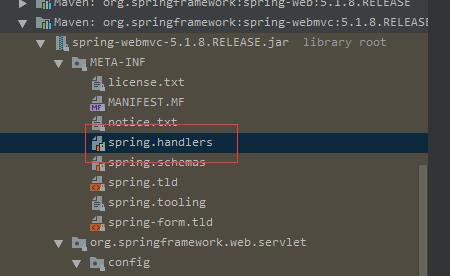
该文件就一行代码:
http\://www.springframework.org/schema/mvc=org.springframework.web.servlet.config.MvcNamespaceHandler//MVC所有的标签解析器都定义在此
public class MvcNamespaceHandler extends NamespaceHandlerSupport {
@Override
public void init() {
registerBeanDefinitionParser("annotation-driven", new AnnotationDrivenBeanDefinitionParser());
registerBeanDefinitionParser("default-servlet-handler", new DefaultServletHandlerBeanDefinitionParser());
registerBeanDefinitionParser("interceptors", new InterceptorsBeanDefinitionParser());
registerBeanDefinitionParser("resources", new ResourcesBeanDefinitionParser());
registerBeanDefinitionParser("view-controller", new ViewControllerBeanDefinitionParser());
registerBeanDefinitionParser("redirect-view-controller", new ViewControllerBeanDefinitionParser());
registerBeanDefinitionParser("status-controller", new ViewControllerBeanDefinitionParser());
registerBeanDefinitionParser("view-resolvers", new ViewResolversBeanDefinitionParser());
registerBeanDefinitionParser("tiles-configurer", new TilesConfigurerBeanDefinitionParser());
registerBeanDefinitionParser("freemarker-configurer", new FreeMarkerConfigurerBeanDefinitionParser());
registerBeanDefinitionParser("groovy-configurer", new GroovyMarkupConfigurerBeanDefinitionParser());
registerBeanDefinitionParser("script-template-configurer", new ScriptTemplateConfigurerBeanDefinitionParser());
registerBeanDefinitionParser("cors", new CorsBeanDefinitionParser());
}
}那么通过分析AnnotationDrivenBeanDefinitionParser类,主要完成以下三大组件的装配工作:
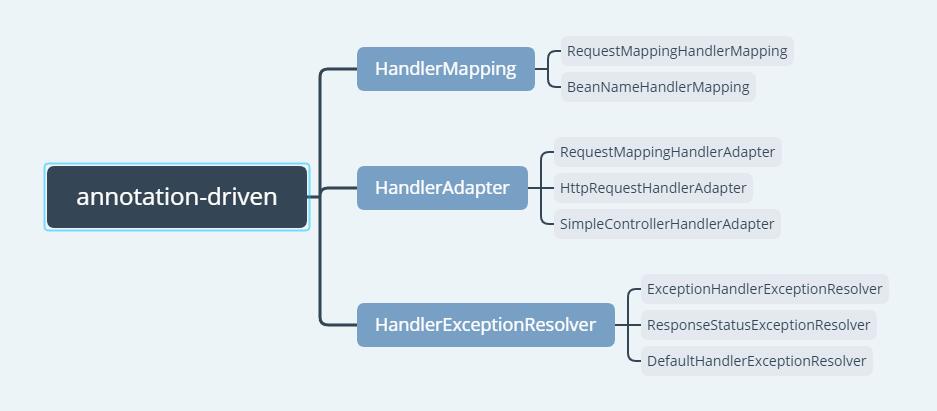
初始化处理器映射器
private void initHandlerMappings(ApplicationContext context) {
this.handlerMappings = null;
//这里detectAllHandlerMappings默认值为true,可以通过配置文件设置为false
if (this.detectAllHandlerMappings) {
//从上下文(包含父上下文)中查找所有HandlerMapping实现类
Map<String, HandlerMapping> matchingBeans =
BeanFactoryUtils.beansOfTypeIncludingAncestors(context, HandlerMapping.class, true, false);
if (!matchingBeans.isEmpty()) {
this.handlerMappings = new ArrayList<>(matchingBeans.values());
AnnotationAwareOrderComparator.sort(this.handlerMappings);
}
}
else {
try {
//这里只取固定的bean
HandlerMapping hm = context.getBean(HANDLER_MAPPING_BEAN_NAME, HandlerMapping.class);
this.handlerMappings = Collections.singletonList(hm);
}
catch (NoSuchBeanDefinitionException ex) {
}
}
/***
确保至少有一个HandlerMapping,如果没能找到,注册一个默认的
默认规则在DispatcherServlet.properties中,这里也就是取BeanNameUrlHandlerMapping、RequestMappingHandlerMapping
***/
if (this.handlerMappings == null) {
this.handlerMappings = getDefaultStrategies(context, HandlerMapping.class);
}
}初始化处理器适配器
private void initHandlerAdapters(ApplicationContext context) {
this.handlerAdapters = null;
if (this.detectAllHandlerAdapters) {
//从上下文(包括父上下文)中查找所有HandlerAdapter实现类
Map<String, HandlerAdapter> matchingBeans =BeanFactoryUtils.beansOfTypeIncludingAncestors(context, HandlerAdapter.class, true, false);
if (!matchingBeans.isEmpty()) {
this.handlerAdapters = new ArrayList<>(matchingBeans.values());
AnnotationAwareOrderComparator.sort(this.handlerAdapters);
}
}
else {
try {
//这里取bean名字为handlerAdapter,类型为HandlerAdapter的处理器适配器
HandlerAdapter ha = context.getBean(HANDLER_ADAPTER_BEAN_NAME, HandlerAdapter.class);
this.handlerAdapters = Collections.singletonList(ha);
}
catch (NoSuchBeanDefinitionException ex) {
}
}
/**
如果没找到,则从默认规则里取出指定的三个实现类:HttpRequestHandlerAdapter、SimpleControllerHandlerAdapter、RequestMappingHandlerAdapter
**/
if (this.handlerAdapters == null) {
this.handlerAdapters = getDefaultStrategies(context, HandlerAdapter.class);
}
}初始化试图解析器
private void initViewResolvers(ApplicationContext context) {
this.viewResolvers = null;
if (this.detectAllViewResolvers) {
//从上下文(包括父上下文)中查找所有ViewResolver实现类
Map<String, ViewResolver> matchingBeans =BeanFactoryUtils.beansOfTypeIncludingAncestors(context, ViewResolver.class, true, false);
if (!matchingBeans.isEmpty()) {
this.viewResolvers = new ArrayList<>(matchingBeans.values());
AnnotationAwareOrderComparator.sort(this.viewResolvers);
}
}
else {
try {
ViewResolver vr = context.getBean(VIEW_RESOLVER_BEAN_NAME, ViewResolver.class);
this.viewResolvers = Collections.singletonList(vr);
}
catch (NoSuchBeanDefinitionException ex) {
}
}
/**
如果没找到,则从默认规则里取出指定的实现类:InternalResourceViewResolver
**/
if (this.viewResolvers == null) {
this.viewResolvers = getDefaultStrategies(context, ViewResolver.class);
}
}? ? ? ? ?三大组件的初始化最后判断为NULL时都会调用getDefaultStrategies方法,也就是从DispatcherServlet.properties中取出指定默认值。
protected <T> List<T> getDefaultStrategies(ApplicationContext context, Class<T> strategyInterface) {
String key = strategyInterface.getName();
String value = defaultStrategies.getProperty(key);
if (value != null) {
String[] classNames = StringUtils.commaDelimitedListToStringArray(value);
List<T> strategies = new ArrayList<>(classNames.length);
for (String className : classNames) {
try {
Class<?> clazz = ClassUtils.forName(className, DispatcherServlet.class.getClassLoader());
Object strategy = createDefaultStrategy(context, clazz);
strategies.add((T) strategy);
}
catch (ClassNotFoundException ex) {
throw new BeanInitializationException("Could not find DispatcherServlet's default strategy class [" + className +"] for interface [" + key + "]", ex);
}
catch (LinkageError err) {
throw new BeanInitializationException("Unresolvable class definition for DispatcherServlet's default strategy class [" +className + "] for interface [" + key + "]", err);
}
}
return strategies;
}
else {
return new LinkedList<>();
}
}DispatcherServlet请求处理过程
? ? ?提到请求处理过程,我们再来回顾一下Servlet生命周期,处理请求都放在service方法中处理,那么也从DispatcherServlet的service方法入手。DispatcherServlet继承FrameworkServlet,在FrameworkServlet中重写了service、doGet、doPost、doPut、doDelete方法。
//FrameworkServlet.java
@Override
protected void service(HttpServletRequest request, HttpServletResponse response)
throws ServletException, IOException {
HttpMethod httpMethod = HttpMethod.resolve(request.getMethod());
if (httpMethod == HttpMethod.PATCH || httpMethod == null) {
processRequest(request, response);
}
else {
super.service(request, response);
}
}
@Override
protected final void doGet(HttpServletRequest request, HttpServletResponse response)
throws ServletException, IOException {
processRequest(request, response);
}
@Override
protected final void doPost(HttpServletRequest request, HttpServletResponse response)
throws ServletException, IOException {
processRequest(request, response);
}
@Override
protected final void doPut(HttpServletRequest request, HttpServletResponse response)
throws ServletException, IOException {
processRequest(request, response);
}
@Override
protected final void doDelete(HttpServletRequest request, HttpServletResponse response)
throws ServletException, IOException {
processRequest(request, response);
}
protected final void processRequest(HttpServletRequest request, HttpServletResponse response)
throws ServletException, IOException {
long startTime = System.currentTimeMillis();
Throwable failureCause = null;
LocaleContext previousLocaleContext = LocaleContextHolder.getLocaleContext();
LocaleContext localeContext = buildLocaleContext(request);
RequestAttributes previousAttributes = RequestContextHolder.getRequestAttributes();
ServletRequestAttributes requestAttributes = buildRequestAttributes(request, response, previousAttributes);
WebAsyncManager asyncManager = WebAsyncUtils.getAsyncManager(request);
asyncManager.registerCallableInterceptor(FrameworkServlet.class.getName(), new RequestBindingInterceptor());
//把新构造的LocaleContext对象和ServletRequestAttributes对象和当前请求线程绑定(后面要解除绑定)
initContextHolders(request, localeContext, requestAttributes);
try {
//抽象方法,交给DispatcherServlet方法实现
doService(request, response);
}
catch (ServletException | IOException ex) {
failureCause = ex;
throw ex;
}
catch (Throwable ex) {
failureCause = ex;
throw new NestedServletException("Request processing failed", ex);
}
finally {
//重置LocaleContext和RequestAttributes对象,也就是解除LocaleContext对象和ServletRequestAttributes对象和当前请求线程的绑定
resetContextHolders(request, previousLocaleContext, previousAttributes);
if (requestAttributes != null) {
requestAttributes.requestCompleted();
}
//发布ServletRequestHandledEvent事件
publishRequestHandledEvent(request, response, startTime, failureCause);
}
}//DispatcherServlet.java
@Override
protected void doService(HttpServletRequest request, HttpServletResponse response) throws Exception {
Map<String, Object> attributesSnapshot = null;
if (WebUtils.isIncludeRequest(request)) {
attributesSnapshot = new HashMap<>();
Enumeration<?> attrNames = request.getAttributeNames();
while (attrNames.hasMoreElements()) {
String attrName = (String) attrNames.nextElement();
if (this.cleanupAfterInclude || attrName.startsWith(DEFAULT_STRATEGIES_PREFIX)) {
attributesSnapshot.put(attrName, request.getAttribute(attrName));
}
}
}
//在当前request对象中填充4个属性
request.setAttribute(WEB_APPLICATION_CONTEXT_ATTRIBUTE, getWebApplicationContext());
request.setAttribute(LOCALE_RESOLVER_ATTRIBUTE, this.localeResolver);
request.setAttribute(THEME_RESOLVER_ATTRIBUTE, this.themeResolver);
request.setAttribute(THEME_SOURCE_ATTRIBUTE, getThemeSource());
if (this.flashMapManager != null) {
FlashMap inputFlashMap = this.flashMapManager.retrieveAndUpdate(request, response);
if (inputFlashMap != null) {
request.setAttribute(INPUT_FLASH_MAP_ATTRIBUTE, Collections.unmodifiableMap(inputFlashMap));
}
request.setAttribute(OUTPUT_FLASH_MAP_ATTRIBUTE, new FlashMap());
request.setAttribute(FLASH_MAP_MANAGER_ATTRIBUTE, this.flashMapManager);
}
try {
//主要处理分发请求
doDispatch(request, response);
}
finally {
if (!WebAsyncUtils.getAsyncManager(request).isConcurrentHandlingStarted()) {
if (attributesSnapshot != null) {
restoreAttributesAfterInclude(request, attributesSnapshot);
}
}
}
}
protected void doDispatch(HttpServletRequest request, HttpServletResponse response) throws Exception {
HttpServletRequest processedRequest = request;
HandlerExecutionChain mappedHandler = null;
boolean multipartRequestParsed = false;
WebAsyncManager asyncManager = WebAsyncUtils.getAsyncManager(request);
try {
ModelAndView mv = null;
Exception dispatchException = null;
try {
processedRequest = checkMultipart(request);
multipartRequestParsed = (processedRequest != request);
//调用handlerMapping获取handlerChain
mappedHandler = getHandler(processedRequest);
if (mappedHandler == null) {
noHandlerFound(processedRequest, response);
return;
}
//获取支持该handler解析的HandlerAdapter
HandlerAdapter ha = getHandlerAdapter(mappedHandler.getHandler());
String method = request.getMethod();
boolean isGet = "GET".equals(method);
if (isGet || "HEAD".equals(method)) {
long lastModified = ha.getLastModified(request, mappedHandler.getHandler());
if (new ServletWebRequest(request, response).checkNotModified(lastModified) && isGet) {
return;
}
}
if (!mappedHandler.applyPreHandle(processedRequest, response)) {
return;
}
//使用HandlerAdapter完成handler处理
mv = ha.handle(processedRequest, response, mappedHandler.getHandler());
if (asyncManager.isConcurrentHandlingStarted()) {
return;
}
//视图处理(页面渲染)
applyDefaultViewName(processedRequest, mv);
mappedHandler.applyPostHandle(processedRequest, response, mv);
}
catch (Exception ex) {
dispatchException = ex;
}
catch (Throwable err) {
dispatchException = new NestedServletException("Handler dispatch failed", err);
}
processDispatchResult(processedRequest, response, mappedHandler, mv, dispatchException);
}
catch (Exception ex) {
triggerAfterCompletion(processedRequest, response, mappedHandler, ex);
}
catch (Throwable err) {
triggerAfterCompletion(processedRequest, response, mappedHandler,new NestedServletException("Handler processing failed", err));
}
finally {
if (asyncManager.isConcurrentHandlingStarted()) {
if (mappedHandler != null) {
mappedHandler.applyAfterConcurrentHandlingStarted(processedRequest, response);
}
}
else {
if (multipartRequestParsed) {
cleanupMultipart(processedRequest);
}
}
}
}? ? ? ? DispatcherServlet的doDispatch方法概括起来大致就是以下几点:首先根据当前请求路径找到对应的HandlerMethod,一个HandlerMethod和若干个拦截器构造一个HandlerExecutionChain.通过HandlerExecutionChain得到HandlerAdapter对象,通过执行HandlerAdapter的handle方法得到ModelAndView对象,调用ModelAndView解析视图,渲染视图,Response结束。
参考
https://juejin.im/post/5cb89dae6fb9a0686b47306d
https://juejin.im/post/5cbc10b46fb9a0689f4c2c22
https://www.cnblogs.com/fangjian0423/p/springMVC-dispatcherServlet.html
原文链接:https://www.cnblogs.com/sword-successful/p/11394370.html
如有疑问请与原作者联系
标签:
版权申明:本站文章部分自网络,如有侵权,请联系:west999com@outlook.com
特别注意:本站所有转载文章言论不代表本站观点,本站所提供的摄影照片,插画,设计作品,如需使用,请与原作者联系,版权归原作者所有
- springboot2配置JavaMelody与springMVC配置JavaMelody 2020-06-11
- JVM常见面试题解析 2020-06-11
- 你说研究过Spring里面的源码,循环依赖你会么? 2020-06-09
- 深入解析ThreadLocal和ThreadLocalMap 2020-06-08
- 通俗理解spring源码(六)—— 默认标签(import、alias、be 2020-06-07
IDC资讯: 主机资讯 注册资讯 托管资讯 vps资讯 网站建设
网站运营: 建站经验 策划盈利 搜索优化 网站推广 免费资源
网络编程: Asp.Net编程 Asp编程 Php编程 Xml编程 Access Mssql Mysql 其它
服务器技术: Web服务器 Ftp服务器 Mail服务器 Dns服务器 安全防护
软件技巧: 其它软件 Word Excel Powerpoint Ghost Vista QQ空间 QQ FlashGet 迅雷
网页制作: FrontPages Dreamweaver Javascript css photoshop fireworks Flash
